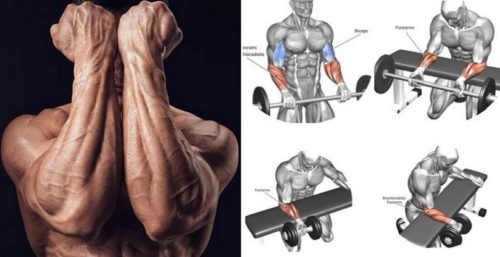Forearm training isn’t easy. It takes a long time to turn flimsy forearms into bulked-up boa constrictors. But it’s possible.
And I’m going to teach you how to do it.
Forearm training differs from “normal” weight lifting
Even in the biggest, strongest bodybuilders, there is very little actual muscle in the forearms. Instead, there’s a ton of tendons, ligaments, and connective tissue. Actual muscle tissue is scarce.
Because of all the connective tissue, it takes a long time to recover from an intense forearm workout. Experienced weight lifters can work their biceps 3 times a week. But even the most hardcore muscle heads generally only work their forearms once (or maybe 2 times) per week. It just takes longer for ligaments and tendons to recover from stress, compared to muscle tissue.
And here’s a little-known fact: forearm training is all about stressing the ligaments and tendons. This is what stimulates muscle growth in the forearms.
The rep range you use for forearms is going to be higher than what you use for most other muscles. While you’re probably accustomed to using 8 to 12 reps for your biceps and chest, you’ll want to double that for your forearms. Sets of 20 or more are acceptable, because this sort of high-rep work stimulates growth in the connective tissue better than lower reps.
Two types of forearm exercise: curls and isometric grip work
It’s not enough to do some forearm curls and call it a day.
You need two types of exercise to fully stimulate forearm growth: curls and grip strength workouts.
Forearm curls (and reverse curls) move the muscle of the lower arm through their full range of motion. They’ll build muscle near your elbow and help you work your upper arms even more intensely. But they don’t build much mass near the wrist.
For that, you need grip work. And the best way to get a good grip workout is to use isometric exercises (movements that don’t move a muscle through a range of motion). Forget those hand-grippers, the best grip work is isometric.
1 – Forearm curls
Forearm curls are the main forearm exercise for building mass throughout the lower arms.
Sit on a bench. Get a barbell with some weight on it and rest it on your thighs. Your hands should be hanging off past your knees, supporting the barbell.
Using a full range of motion, curl the barbell up and down. Don’t be afraid to let the bar roll down to your fingertips at the bottom of the movement. Go slow and keep the weight moderate at first. Remember that forearm training takes time; you can’t do it all in a month.
2 – Reverse forearm curls
Reverse forearm curls are similar to regular forearm curls, but you wont’ be able to use anywhere near as much weight.
This exercise strengthens the thumb and adds a bit of muscle mass near the wrist.
Just keep your palms facing down as you hold the barbell in the forearm curl position. Curl through a full range of motion and take it slow.
3 – Behind the back forearm curls
This is a favorite forearm exercise for a lot of guys. You can use more weight with behind-the-back forearm curls than with strict, seated forearm curls.
Hold the barbell behind your back and simply curl it up and down, moving only through your wrists. You’ll really “feel the burn” with this one.
4 – Grip strength exercise
Finally, work on your grip strength. The best way to do this is to simply hold a very heavy dumbbell in each hand and walk around with it. This is called a farmer’s walk and it rapidly strengthens your gripping strength and stimulates growth in the area near your wrists.
Another good grip-strength exercise is isometric towel hangs. Throw a towel over a pull-up bar and grab it in one hand. Then, simply hang from the towel. If it is difficult to grip the thick towel hard enough to hang there very long, just use two towels — one for each hand.
5 – Reverse curls
This isn’t only a forearm exercise. It works the brachioradialis muscle near the elbow and under the biceps. But since it does put some meat on your upper forearm, you should do a few sets from time to time, after your biceps workout is over.



Post your comment